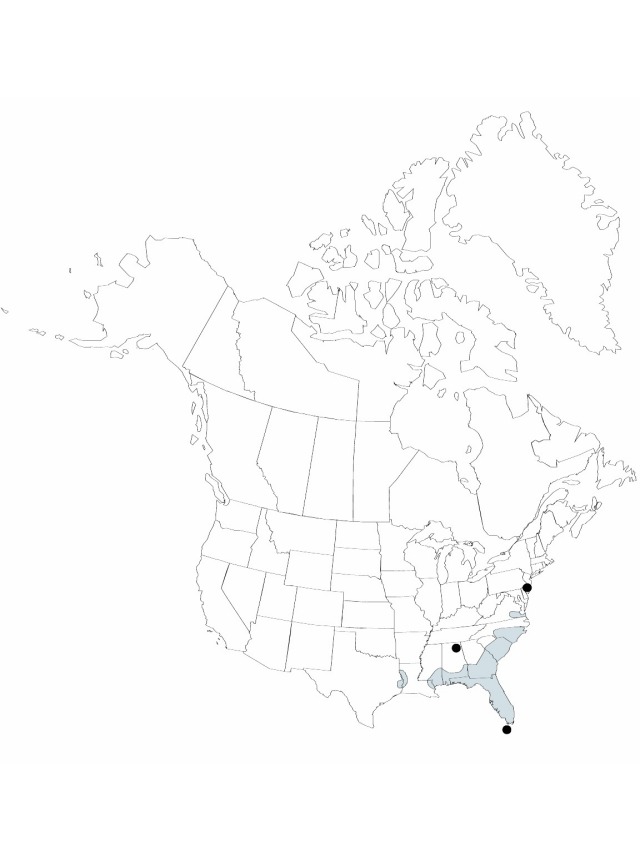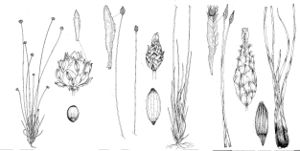Difference between revisions of "Xyris caroliniana"
Flora Caroliniana, secundum. 69. 1788.
FNA>Volume Importer |
FNA>Volume Importer |
||
| Line 7: | Line 7: | ||
|year=1788 | |year=1788 | ||
}} | }} | ||
| − | |basionyms={{Treatment/ID/ | + | |basionyms={{Treatment/ID/Basionym |
|name=Xyris arenicola | |name=Xyris arenicola | ||
|authority=Small | |authority=Small | ||
| − | }} {{Treatment/ID/ | + | |publication_title= |
| + | |publication_place=1903, | ||
| + | }} {{Treatment/ID/Basionym | ||
|name=Xyris torta | |name=Xyris torta | ||
|authority=unknown | |authority=unknown | ||
| + | |publication_title= | ||
| + | |publication_place=1843, | ||
}} | }} | ||
|synonyms={{Treatment/ID/Synonym | |synonyms={{Treatment/ID/Synonym | ||
| Line 44: | Line 48: | ||
|elevation=0–300 m | |elevation=0–300 m | ||
|distribution=Ala.;Fla.;Ga.;La.;Miss.;N.J.;N.C.;S.C.;Tex.;Va.;West Indies (Cuba). | |distribution=Ala.;Fla.;Ga.;La.;Miss.;N.J.;N.C.;S.C.;Tex.;Va.;West Indies (Cuba). | ||
| − | |discussion=<p>In Florida and the lower Gulf Coastal Plain west to Mississippi are paler-leaved, white-petaled examples that have been treated as <i>Xyris</i> flexuosa <i></i>var.<i> pallescens</i> (C. Mohr) Barnhart. These indeed are always in uniform populations but differ in no other significant way from the species. Since from typical plants. Because some other <i>Xyris</i> have white-flowered morphs (particularly <i>X. platylepis</i>), these are regarded as too close to be distinguished as varieties. Populational studies are in order, however.</p> | + | |discussion=<p>In Florida and the lower Gulf Coastal Plain west to Mississippi are paler-leaved, white-petaled examples that have been treated as <i>Xyris</i> flexuosa <i></i></i>var.<i><i> pallescens</i> (C. Mohr) Barnhart. These indeed are always in uniform populations but differ in no other significant way from the species. Since from typical plants. Because some other <i>Xyris</i> have white-flowered morphs (particularly <i>X. platylepis</i>), these are regarded as too close to be distinguished as varieties. Populational studies are in order, however.</p> |
|tables= | |tables= | ||
|references= | |references= | ||
| Line 68: | Line 72: | ||
|publication year=1788 | |publication year=1788 | ||
|special status= | |special status= | ||
| − | |source xml=https://jpend@bitbucket.org/aafc-mbb/fna-data-curation.git/src/ | + | |source xml=https://jpend@bitbucket.org/aafc-mbb/fna-data-curation.git/src/f6b125a955440c0872999024f038d74684f65921/coarse_grained_fna_xml/V22/V22_453.xml |
|genus=Xyris | |genus=Xyris | ||
|species=Xyris caroliniana | |species=Xyris caroliniana | ||
Revision as of 19:03, 24 September 2019
Herbs, perennial, usually cespitose, 30–80(–100) cm, base deeply set. Stems compact. Leaves erect or ascending, 20–50 cm; sheath base chestnut brown; blade green, narrowly linear, twisted, 2–5 mm wide, compressed but fleshy, margins minutely tuberculate. Inflorescences: scape sheaths much exceeded by leaves; scapes linear, wiry, flexuous, nearly terete, 1.2–1.5 mm wide, distally 1-ribbed, rib smooth or somewhat scabrous; spikes ellipsoid to lanceoloid or cylindric, 10–30 mm, apex acute; fertile bracts 5–10(–13) mm, margins entire or erose, apex rounded. Flowers: lateral sepals conspicuously exserted, tan to reddish brown, nearly straight, 13–15 mm (including long hairs), keel firm, apex long-fimbriate, fimbriae red; petals unfolding in afternoon, blade obovate, 8–10 mm; staminodes bearded. Seeds translucent, cylindro-fusiform, 0.8–1 mm, with flat, longitudinal ribs. 2n = 18.
Phenology: Flowering summer–fall.
Habitat: Moist sands of pine savannas, bog edges, upper shores, flatwoods, sandy coastal dune swales, coastal plain
Elevation: 0–300 m
Distribution

Ala., Fla., Ga., La., Miss., N.J., N.C., S.C., Tex., Va., West Indies (Cuba).
Discussion
In Florida and the lower Gulf Coastal Plain west to Mississippi are paler-leaved, white-petaled examples that have been treated as Xyris flexuosa var. pallescens (C. Mohr) Barnhart. These indeed are always in uniform populations but differ in no other significant way from the species. Since from typical plants. Because some other Xyris have white-flowered morphs (particularly X. platylepis), these are regarded as too close to be distinguished as varieties. Populational studies are in order, however.
Selected References
None.
